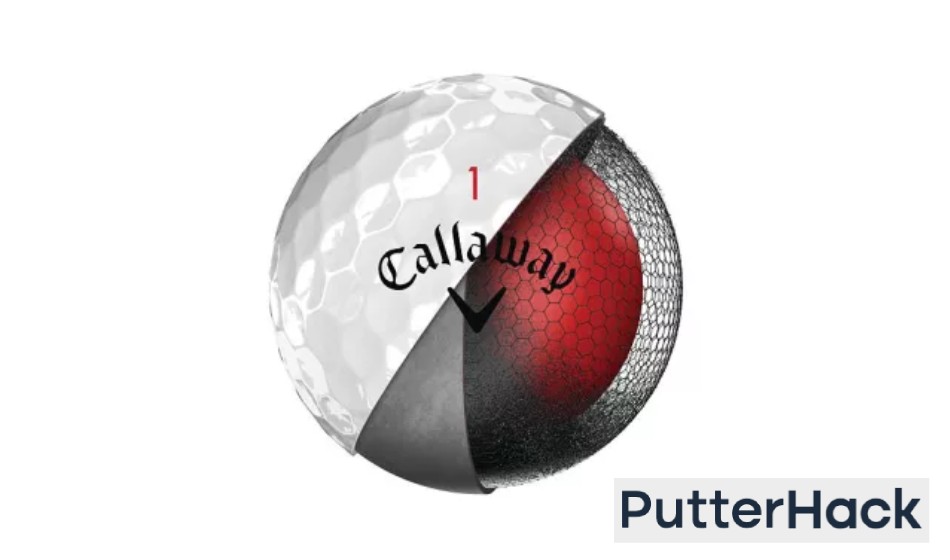
What’s Inside Golf Balls
17 de February de 2024
Imagine a perfect sphere, designed to fly through the air with millimeter precision. That’s a golf ball, but its magic doesn’t end with its impeccable exterior. Have you ever wondered what secrets it hides in its core? Today, we’re going to dive into the very heart of golf balls to discover their interior.
Golf balls are much more than simple round objects; they are the result of advanced engineering. Each layer, each material, has a specific purpose and contributes to the overall performance. Let’s explore together the science and technology that turn these spheres into essential elements for any golfer.
From their composition to the way the internal structure affects their behavior on the field, the golf ball is a small marvel of design. Get ready to be amazed by what a simple glance cannot reveal. It’s time to delve into the fascinating world that lies beneath the surface of golf balls.
Structures of Golf Balls
Golf balls are much more than simple white spheres. Their design is a testament to engineering and physics, and it is crucial for performance on the field. Let’s dive into the science behind these balls:
- One-layer construction: These balls, known as ‘balatas’, are the most basic and traditional. They have a solid rubber core, surrounded by a durable cover. They are perfect for players looking for maximum sensitivity in their shots.
- Two-layer balls: They are the preferred choice for many golfers. With an inner core and a durable cover, they offer an ideal balance between distance and control. Ideal for those looking to improve their game without complications.
- Three-layer balls: These balls add an intermediate layer that optimizes spin and response to impact. They are the choice of advanced players who want more refined control over the ball on the green.
- Multilayer construction: Balls with four or more layers are at the forefront of golf technology. Each layer is designed for a specific purpose, from maximizing distance to improving spin and feel upon impact. They are the favorites of professionals and serious players.
Understanding the structure of your golf ball is key to selecting the one that best suits your style of play. Now that you know the differences, are you ready to choose your perfect ally on the field?
Core Components and Materials
The core is the heart of the golf ball and its composition is vital for performance on the field. It is here where the distance and control of each shot are defined. Let’s see what makes it so special.
Traditionally, the core was made of solid rubber, but technological innovation has led to the use of composite materials. These materials provide a unique combination of softness and elasticity, essential for rebound energy.
The most common materials include:
- Polybutadiene, a type of synthetic rubber that offers exceptional resistance and durability.
- Thermoplastic resins, which help adjust the feeling of softness upon impact.
- Ionomer compounds, which improve energy transfer from the club to the ball.
Advanced technology has also allowed the creation of cores with multiple layers. Each one with specific properties that affect the rotation and speed of the ball. Thus, players can choose the ball that best suits their style of play.
The core is not simply a piece of material; it is an ingeniously designed piece that propels your game to new heights. The next time you hit the ball, remember that there is a world of science and design behind that perfect flight.
Layers and Their Impact on Performance
The layers of a golf ball are crucial for its performance on the field. Each stratum is designed to optimize different aspects of the game, from control to distance. A multilayered ball can have between two and five layers. Each one fulfills a specific function, working in harmony to improve your game.
The outermost layer, or the cover, is generally made of urethane or Surlyn. Urethane favors touch and control, ideal for advanced players, while Surlyn offers durability and is more forgiving with erratic shots. Just below, we find the cover layer. This intermediate layer contributes to the effect and response of the ball, allowing better handling in short shots.
The core, the heart of the ball, is responsible for compression and the energy transferred from the club. A solid core can mean greater distance, especially beneficial for those with fast swings.
- Two-layer balls are perfect for beginners, privileging distance over control.
- Three-layer balls offer a balance between control and distance, ideal for intermediate players.
- Four or more layer balls are the choice of professionals, who seek precise control and specific sensations upon impact.
Understanding the impact of layers on performance can help you select the perfect golf ball for your style of play. Adjust your choice according to what you need: more distance, better control, or a middle ground? Your golf ball can be your best ally on the field.
Varieties of Covers and Their Characteristics
Golf balls may seem simple at first glance, but their design is the result of complex science. The cover, specifically, is crucial for game performance. Let’s explore the varieties of covers and what each one brings to the ball’s flight.
Surlyn
This material is a favorite in the world of golf for its durability and resistance. Balls with a Surlyn cover tend to have a longer lifespan, resisting strong hits without easily getting damaged. Ideal for golfers looking for a balance between performance and durability.
Uretano
Urethane covers are the choice of professionals. They provide greater control and a soft touch upon impact, allowing players to execute shots with greater precision and effect. Although less durable than Surlyn, their performance in the short game is unmatched.
Ionomer
Balls covered in ionomer are at a midpoint between Surlyn and urethane. They offer good durability and better control than Surlyn, but without reaching the level of sensitivity of urethane. They are an excellent option for intermediate-level players.
In addition to these materials, technology continues to advance, and now we find hybrid covers that seek to combine the best of both worlds. The choice will depend on the skill level, style of play, and, of course, personal preferences. There is no single answer; each golfer has their ideal cover.
Technologies and Innovative Design in Golf Balls
The science behind golf balls has evolved significantly. Today, these small spheres are a marvel of engineering, designed to maximize performance with every hit. Let’s see what technologies and innovative designs make them so special.
First, the composition of multiple layers. Modern golf balls can have from two to five layers, each with a distinct purpose. These range from improving distance to controlling spin. The key is in the synergy between them to offer a perfect balance.
Another advancement is core technology. Cores are designed to compress upon impact, which determines the speed and energy of the ball. Materials like styrene-butadiene rubber (SBS) or polybutadiene are common, and their manipulation is an art that defines the quality of the game.
The design of the cover is also crucial. Materials like urethane offer a soft feel and greater spin on approach shots. Harder covers, on the other hand, provide greater distance and durability. The choice depends on the player’s style and needs.
Aerodynamics is another fundamental aspect. Dimple patterns are meticulously designed to control airflow and stabilize the ball during flight. They vary in size, depth, and pattern, each combination seeking a specific advantage.
Lastly, the integration of tracking technology is on the rise. With smart chips embedded, balls can provide data on distance and accuracy of shots. This technology is a window towards the continuous improvement of the player.
Today’s golf balls are technological wonders. Their design and manufacturing are the result of years of research and development, with the clear goal of improving every aspect of the game. The next time you hold one, remember that you have in your hands a concentrate of innovation.
As we delve into the fascinating inner world of golf balls, we discover that each layer tells a story of engineering and design. The precise composition of these small spheroids is not a game of chance; it’s science at its finest, dedicated to enhancing your experience on the field.
Remember, the next time you prepare for a swing, that you’re not just hitting a ball, but a masterpiece of sports technology. Choose the right ball for your style of play, and you’ll feel the difference with every hit.
In your quest for that perfect round, keep in mind that the golf ball is your ally. Knowing its interior gives you that tactical advantage to select the best option for you. Because at the end of the day, every detail counts in the game of golf.
We hope this journey into the heart of golf balls has inspired you and equipped you with useful knowledge. Keep exploring, practicing, and above all, enjoying the game. See you on the green!
